Top 6 Halloween Safety Tips for Pets
Posted: 08/06/2023 | BY: Erin Cain | Categories: Cat , Dog , Pet care , Top Tips
Halloween is a fun and festive time of year for many of us. But for our pets, it can be a stressful and dangerous holiday. Protecting your pet on Halloween is a responsibility that worries many pet parents each year. Here are our best Halloween safety tips for pets, so you can keep your cat or dog safe this year.
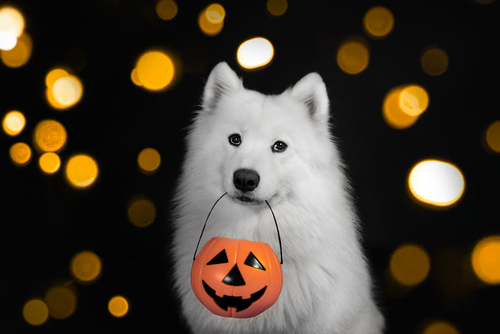
1. Keep candy out of reach.
Candy is almost always the number one Halloween safety tip for Pets. Dogs and cats are attracted to the sweet smell of candy, but chocolate and raisins can be toxic to them. Avoid giving your pets any treats or food items. Sugar-free candy, gum, and baked goods contain xylitol, also called birch sugar. These substances are poisonous and should be kept away from pets.
Sweets with chocolate are especially dangerous for dogs and cats. Theobromine is a natural stimulant found in chocolate that can hurt dogs and cats if they overeat it. The severity of chocolate toxicity varies depending on the type and amount eaten, with darker chocolates being more harmful.
The risk of chocolate toxicity in pets is highest for smaller pets. A 20-pound dog that eats 3 ounces of chocolate can have severe vomiting and diarrhea. On the other hand, an 80-pound dog needs 11 ounces of chocolate to get the same effects.
Call a veterinarian immediately if you think that your pet has eaten any of the following hazards:
- xylitol (birch sugar)
- tinfoil or cellophane
- plastic candy wrappers (which may cause injury or obstruction if swallowed)
Make sure to keep all candy, especially chocolate, well out of reach of your pets.
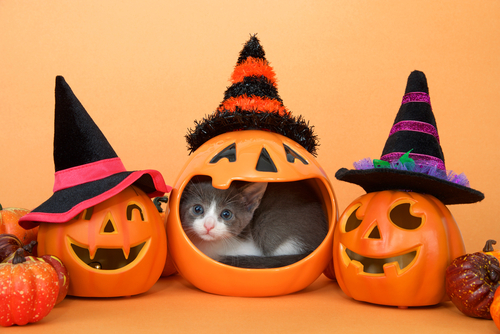
2 Create a safe space.
The best thing you can do for pets sensitive to Halloween stress is to provide a safe space. It’s always safer if your pet stays inside on holidays like this one. Loud noises, strange people, and constant doorbell ringing can make your pet feel uneasy, stressed, and even ill.
Keep your pet safe by creating a little haven for them in an area they are familiar with. They should have their own space, such as a bathroom or spare bedroom, where it feels comfortable and welcoming. Provide bedding, blankets, and toys to help calm your pet’s fears. You can also turn on the TV or use a white noise machine in the pet’s space to drown out some of the loud noises that come with Halloween.

3. Beware of costume dangers.
Another important Halloween safety tips for pets concerns those cute costumes that some pet owners have their pets wear. If you dress up your pet for Halloween, make sure the costume is comfortable and doesn’t restrict their movement or vision. Know the risks of dressing your pet in a particular fabric or accessory. Some materials can seriously harm your pet’s health.
Beware of components like tassels hanging off the costume fabric. Some pets may be tempted to chew on them and swallow them. Some of the most dangerous pieces in any Halloween costume are those that secure it, like buttons and buckles. It’s essential to ensure these aren’t too tight, or they might cut off circulation. Also, keep an eye on your pet to ensure they don’t overheat in their costume, especially if you live in a warm area with high temperatures.
Also, avoid using any type of candle near your pet while wearing an outfit—you don’t want them to set themselves on fire accidentally!
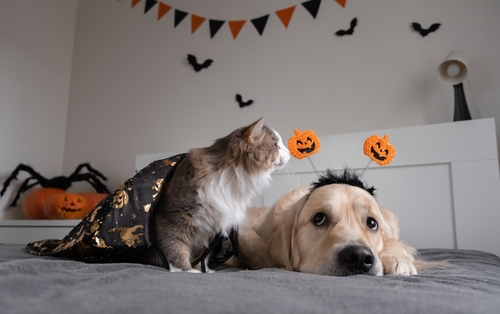
4. Make sure your pet’s identification is up to date.
Halloween can be scary for some pets. During trick-or-treat hours, your cat or dog might be spooked by how often the front door opens and closes. If your pet escapes when this happens, then there’s an increased chance of them being returned home if they have up-to-date identification securely fastened to their collar.
Aside from updating any necessary information on your pet’s ID tag, you should check that your pet’s collar fits and won’t slip off your pet’s neck. Ensure that the ID tag on the collar is fastened securely. Consider microchipping your pet if they are not already. The first thing a shelter volunteer or veterinarian does when they find a lost pet is scan for microchips. The chip will give your contact information so people can contact you and reunite you with your pet. Chip your dog or cat, then keep their contact information updated.
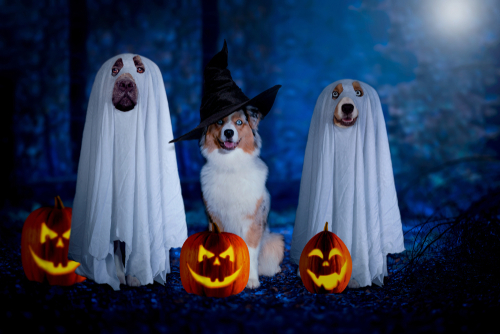
5. It’s a no-go on glow sticks.
Halloween safety tips for cats sometimes cover what trick-or-treaters bring to your door. Children often carry glow sticks through the darkening streets to stay safe as they trick-or-treat. Unfortunately, pets, especially cats, find them fun. Glow sticks become dangerous if they break open, and as most glow sticks consist of cheap plastic, they break apart often.
Although the liquid inside glow sticks, called dibutyl phthalate, is labeled non-toxic, ingestion of this chemical can make a person or a pet ill. If a pet drinks glow stick liquid, they will become hyperactive (running around the house) and experience excessive drooling.
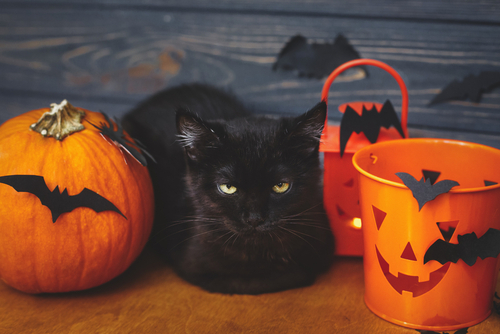
6. Pumpkins and pets don’t mix.
While plain pumpkin puree is safe and beneficial for pets to eat, the actual pumpkin itself is not. Pumpkins are not toxic; however, if your pet consumes a portion of one, they may experience severe stomach upset.
If you place a light in your jack-o-lanterns, be sure the pumpkins are not within your pet’s reach. It doesn’t take much for a spry cat or fluffy dog tail to knock over a lit pumpkin and suffer burns.
Protect your pet this Halloween.
Use these Halloween safety tips for pets to keep your pet safe this year. Always remember that accidents can still happen, no matter how prepared you and your pet are. A pet health insurance plan helps cover most of the costs associated with your dog’s or cat’s emergency care. Protect your pet, and get them a free pet insurance quote now.
References:
- The Farmer’s Dog. (2022). Xylitol is the Same as Birch Sugar (and It’s Toxic to Dogs). Retrieved from https://www.thefarmersdog.com/digest/xylitol-is-the-same-as-birch-sugar-and-its-toxic-to-dogs/
- AKC Staff. (2022). What to Do if Your Dog Eats Chocolate. Retrieved from https://www.akc.org/expert-advice/health/what-to-do-if-your-dog-ate-chocolate/
- Mlynar, P. (2022). Dibutyl Phthalate (Glow Stick) Ingestion in Dogs: Symptoms, Causes & Treatments. Retrieved from https://dogtime.com/dog-health/92130-dibutyl-phthalate-glow-stick-ingestion-dogs-symptoms-causes-treatments
- Cain, E. (2022). Calming Dogs with Storm Phobias. Retrieved from https://www.petinsurancereview.com/blog/methods-for-calming-dogs-with-storm-phobias
- Cain, E. (2022). The Top 10 Veterinary Costs Associated with Dogs. Retrieved from https://www.petinsurancereview.com/blog/top-10-veterinary-costs-associated-dogs
Disclaimer
The information contained on this blog is intended for informational and educational purposes only and should not be construed as medical advice. It is not a substitute for professional veterinary care. Always consult with your veterinarian before making any changes to your pet's health care or treatment plan.
The authors of this blog are not veterinarians and do not claim to be experts in pet health. The information provided here is based on our own experiences and research, as well as information from reputable sources. However, we cannot guarantee the accuracy or completeness of this information.
We encourage you to do your own research and consult with your veterinarian before making any decisions about your pet's health.
Previous post
Should You Worry About That Lump on Your Dog?Compare top pet insurance providers plans.
Enter your dog’s age in years and months to calculate their age equivalent to human years.
Calculate your dog’s ageEnter your cat’s age in years and months to calculate their age equivalent to human years.
Calculate your cat’s age